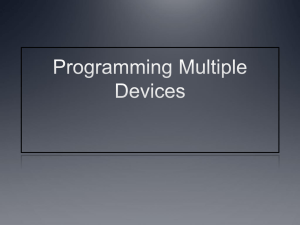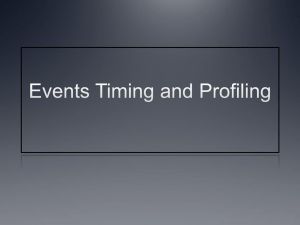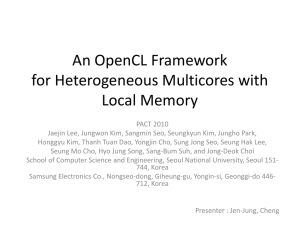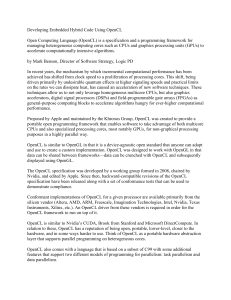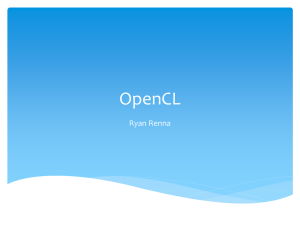OpenCL-short
advertisement
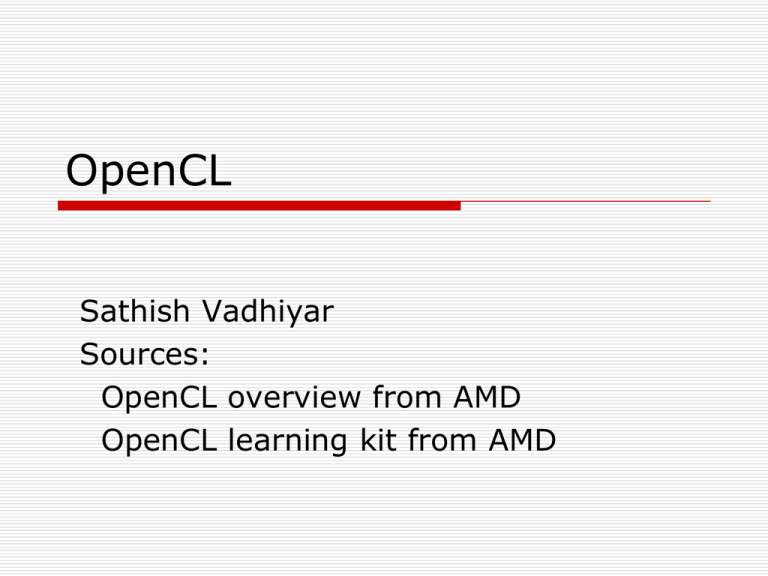
OpenCL Sathish Vadhiyar Sources: OpenCL overview from AMD OpenCL learning kit from AMD Introduction OpenCL is a programming framework for heterogeneous computing resources Resources include CPUs, GPUs, Cell Broadband Engine, FPGAs, DSPs Many similarities with CUDA Command Queues A command queue is the mechanism for the host to request that an action be performed by the device Perform a memory transfer, begin executing, etc. Interesting concept of enqueuing kernels and satisfying dependencies using events A separate command queue is required for each device Commands within the queue can be synchronous or asynchronous Commands can execute in-order or out-of-order Perhaad Mistry & Dana Schaa, Northeastern Univ Computer Architecture Research Lab, with Ben 4 Example – Image Rotation Slides 8, 11-16 of lecture 5 in openCL University kit Synchronization Synchronization in OpenCL Synchronization is required if we use an out-of-order command queue or multiple command queues Coarse synchronization granularity Per command queue basis Finer synchronization granularity Per OpenCL operation basis using events Perhaad Mistry & Dana Schaa, Northeastern Univ Computer Architecture Research Lab, with Ben 8 OpenCL Command Queue Control Command queue synchronization methods work on a per-queue basis Flush: clFlush(cl_commandqueue) Send all commands in the queue to the compute device No guarantee that they will be complete when clFlush returns Finish: clFinish(cl_commandqueue) Waits for all commands in the command queue to complete before proceeding (host blocks on this call) Barrier: clEnqueueBarrier(cl_commandqueue) Enqueue a synchronization point that ensures all prior commands in a queue have completed before any further commands execute Perhaad Mistry & Dana Schaa, Northeastern Univ Computer Architecture Research Lab, with Ben 9 OpenCL Events Previous OpenCL synchronization functions only operated on a percommand-queue granularity OpenCL events are needed to synchronize at a function granularity Explicit synchronization is required for Out-of-order command queues Multiple command queues Perhaad Mistry & Dana Schaa, Northeastern Univ Computer Architecture Research Lab, with Ben 10 Using User Events A simple example of user events being triggered and used in a command queue //Create user event which will start the write of buf1 user_event = clCreateUserEvent(ctx, NULL); clEnqueueWriteBuffer( cq, buf1, CL_FALSE, ..., 1, &user_event , NULL); //The write of buf1 is now enqued and waiting on user_event X = foo(); //Lots of complicated host processing code clSetUserEventStatus(user_event, CL_COMPLETE); //The clEnqueueWriteBuffer to buf1 can now proceed as per OP of foo() Perhaad Mistry & Dana Schaa, Northeastern Univ Computer Architecture Research Lab, with Ben 11 Multiple Devices Multiple Devices OpenCL can also be used to program multiple devices (CPU, GPU, Cell, DSP etc.) OpenCL does not assume that data can be transferred directly between devices, so commands only exists to move from a host to device, or device to host Copying from one device to another requires an intermediate transfer to the host OpenCL events are used to synchronize execution on different devices within a context Compiling Code for Multiple Devices
